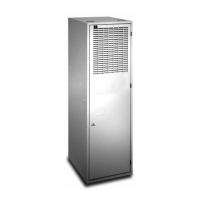6
MAINTENANCE INFORMATION
Proper maintenance is important to achieve optimum performance from the furnace. This equipment should be
inspectedannuallybyalicensedHVACtechnician.Table1(page7)containssuggestedinspectionsandfrequency
of maintenance. Routine maintenance should include the following:
BLOWER & FILTER
• Neveroperatethefurnacewithoutalterinplace.Dust
and lint can build up on internal components, resulting
in loss of efficiency, equipment damage, and possible
fire.
• Keepairlterscleaned.Filtersshouldbechangedor
cleaned monthly during the heating/cooling season.
Clean or replace filter to maintain proper airflow and
achieve maximum efficiency. Newly built or renovated
homes may require more frequent changing until the
construction dust has minimized. Filters designed to
remove smaller particles such as pollen, may require
additional maintenance.
• It is recommended that the blower compartment be
cleaned of dirt or lint that may have accumulated in the
compartment or on the blower and motor as part of the
annual inspection.
CONDENSATE DRAINAGE
• This furnace produces liquid condensate which is
slightly acidic. The vent pipe must be sloped upwards
away from the furnace to properly drain the water back
into the condensate disposal system.
• Condensate drain tubes must maintain a downward
slope to ensure proper drainage. Periodically inspect
the condensate drain tube for proper drainage. Also,
do not place heavy objects on the tubing that restricts
the flow of condensate.
FURNACE & AIR DUCTS
• Homeowners should perform frequent visual
inspections of the furnace for obvious signs of
deterioration. The furnace should be sound without
sagging, cracks gaps, etc around the base. The return
air duct connection(s) is secured and sealed to the
furnace cabinet and terminates outside the area
containing the furnace. Any signs of damage or loose
connectionsshould berepairedbyaqualiedHVAC
technician.
• Furniture and drapery should be arranged so that
the supply air registers and return grilles are not
obstructed.
• Ifhouseisnewlybuilt,theoperationofagasfurnace
in a construction environment can cause a variety
of problems with the furnace. Before occupying the
residence, homeowners should have these safety
inspections performed by a licensed technician:
– Theltermustbereplaced(orcleaned)andthe
furnace must be inspected by a licensed HVAC
technician.
– The furnace must be cleaned and/or repaired if
found to be dirty, damaged, or malfunctioning in any
way.
– Before occupancy, the furnace shall be inspected
and approved by applicable local authority even if
this results in redundant inspections.
– The duct work must be inspected and cleaned if
found to contain any construction debris.
VENTING SYSTEM
• Forproperandsafeoperation,thefurnaceneedsairfor
combustion and ventilation. Do Not block or obstruct
air openings on the furnace, or any air openings
where the furnace may be installed, including any
surrounding spaces.
• Direct vent furnaces pull combustion air from the
outdoors and vent combustion products back outside.
Combustion air coming from the outside needs to be
clean of chemicals that can cause corrosion, such as
pool chlorinating products.
• Ventpipemustslopeupwardsandbephysicallysound
without holes or corrosion. Any corroded section
of vent pipe must be replaced, and any obstruction
or blockage must be removed by a licensed HVAC
technician.
• Fluepassageways,theventsystem,andtheburners
should be inspected and cleaned (if required) by
a licensed HVAC technician annually to ensure
continued safe operation.
TROUBLESHOOTING
Ifthefurnacefailstooperatecheckthefollowing:
1.Isthethermostatsettingcorrect?
2.IstheON/OFFswitchinsidethefrontdoorturnedon?
SeeFigure3(page8)forswitchlocation.
3.Isthecircuitbreakertripped?
4.Isthegasturnedonatthemanualshutoff?
5.Isthelterdirtyorclogged?
If the furnace still doesn’t operate, contact a licensed
HVACtechnician

